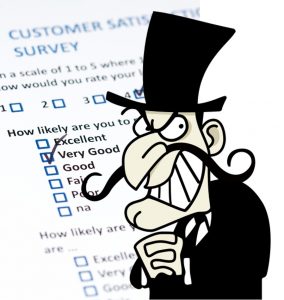Mar
06

Posted by nnlmneo on March 6th, 2017
Posted in: Questionnaires and Surveys

People in my social media circles have been talking lately about bias in questionnaires. There are biased questionnaires. Some of them are biased by accident and some are on purpose. Some are biased in the questions and some are biased in other ways, such as the selection of the people who are asked to complete the questionnaires. Recently, a couple of my friends posted on Facebook that people should check out the NNLM Evaluation Office to learn about better questionnaires. Huzzah! This week’s post was born!
Here are a few things to look for when creating, responding to, or looking at the results of questionnaires.
Poorly worded questions
Sometimes simple problems with questions can lead to bias, whether accidental or on purpose. Watch out for these kinds of questions:
Example:
Overall, how would you rate NIHSeniorHealth?
Excellent | Very Good | Good | Fair | Poor
Notice that “Good” is the middle option (which should be neutral), and some people consider “Fair” to be a slightly positive term.
Example:
Most people find MedlinePlus very easy to navigate. Do you find it easy to navigate? (Yes No)
How would you feel if you had trouble navigating MedlinePlus? It would be hard to say ‘No’ to that question.
Example:
Do you want so lower the cost of health care and limit compensation to medical malpractice lawsuits?
This question has two parts – to answer yes or no, you have to agree or disagree with both parts. And who doesn’t want to lower health care costs?
Example:
Are you in favor of slowing the increase in autism by allowing people to choose whether or not to vaccinate their child?
This question makes the assumption that vaccinations cause autism. It might be difficult to answer if you don’t agree with that assumption.
The NEO has some suggestions for writing questions in their Booklet 3: Collecting and Analyzing Evaluation Data, page 5-7.
Questionnaire respondents
People think of the questions as a way to bias questionnaires, but another form of bias can be found in the questionnaire respondents.
Lastly, the Purpose of the Questionnaire
Just like looking for bias in news or health information or anything else, you want to think about is who is putting out the questionnaire and what is its purpose? A questionnaire isn’t always a tool for objectively gathering data. Here are some other things a questionnaire can be used for:
If you want to know more about questionnaires, here are some of the NEO resources that can help:
Boosting Response Rates with Invitation Letters
More NEO Shop Talk blog posts about Questionnaires and Surveys
Picture attribution
Villano by J.J., licensed under the Creative Commons Attribution-Share Alike 3.0 Unported license.